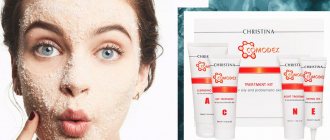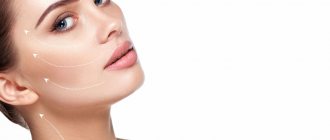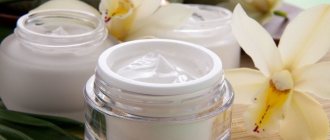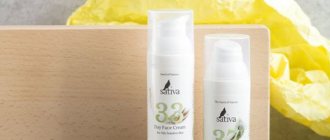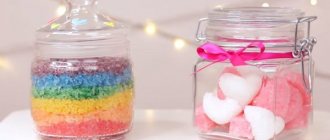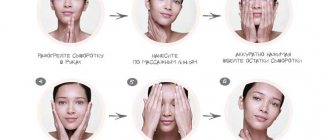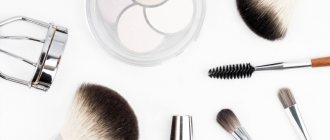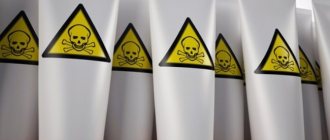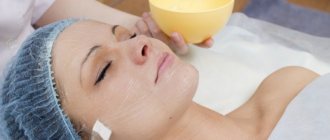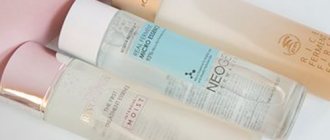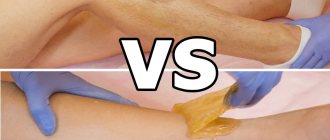Cosmetics classes
Today, cosmetics are usually divided into the following classes:
- mass market;
- middle market;
- lux.
The determining factor in such a system is the price and popularity of the brand.
The phrase mass market is understandable on an intuitive level; such cosmetics are also called “mass” and include products that are inexpensive and accessible to the majority.
When we hear the definition of “luxury”, we associate it with something expensive and luxurious, “professional cosmetics” with efficiency.
Luxury class
Luxury products include expensive products from well-known brands with a worldwide reputation. The list of brands is not very wide: Shiseido, Clarins, Christian Dior, Helena Rubinstein, Guerlain, Chanel, Nina Ricci, Elizabeth Arden, Clinique, Estee Lauder.
Such products meet quality standards, but their price is very high for other reasons. It includes packaging that is specially designed by famous designers plus the brand name. When you buy Lancome or Yves Saint Laurent products, you are experiencing high fashion and luxury.
If you are thinking whether it is possible to find effective cosmetics among more inexpensive brands, then yes - these are products of the middle price segment or middle market class. The word "average" here does not refer to quality, but to the price, which is less than luxury only due to the lack of a big name.
Mass market
Funds belonging to this category are also called “massive”. It contains the largest number of brands. In turn, the class is divided into high, medium and low mass market. Often products from the high segment are also classified as “middle market”.
We also periodically hear about premium products. But if you put several marketers side by side and ask them to name specific brands, you will hear completely different answers. Some will name IsaDora or L'Oreal, and some will name Lancome. The reason for this disagreement is the term “premium” itself, which is translated from English as “higher grade” or “higher price”. This explains why Lancome luxury products, as well as L'Oreal, which are higher than other mass brands, are included in this category. Many experts are inclined to believe that the premium class is the middle market.
Professional cosmetics
It stands apart on the general scale. Here all experts agree on its definition. Such products are used only by qualified cosmetologists and dermatologists. They cannot be sold in retail stores. You can find such products only in beauty salons and aesthetic medicine clinics. An example of real professional cosmetics are mesotherapy preparations administered subcutaneously, as well as acids used for peeling. If a person without special education uses such a solution, he will most likely receive a chemical burn. Even harmless drugs in high concentrations are dangerous.
Professional products can be compared to prescription drugs, which are prescribed only after consultation with a doctor and used under his supervision. The cosmetologist, acting as such a doctor, decides which drug to choose, in what dose to use and for how long to use. Another difference between such products is the high concentration of active substances in their composition; they can cause significant harm if used incorrectly.
But there is also an excellent interpretation of this class; it includes retail lines of products from professional brands that are accessible to anyone. The amount of active substances in their composition does not exceed that contained in products of the middle or luxury classes. From which it follows that their effectiveness is also no higher.
But there is another type of pseudo-professional line, when unscrupulous mass-market manufacturers write “professional cosmetics” on the packaging. This is the easiest proven way to build trust in your products, as such a designation is associated with quality.
What class are Faberlic products?
Marketers classify Faberlic products as middle-market products, but in terms of composition and effectiveness they correspond to the “luxury” level.
Employees of our own Scientific Center constantly monitor innovative developments about the biology of the skin, carried out in all the world's largest laboratories. They purchase the newest and most effective high-tech ingredients.
Faberlic has a patent for the use of perfluorocarbons - the oxygen complex NOVAftem-O2, which enhances the effect of any cosmetic ingredients.
The price of the Company’s goods remains in the middle segment due to a conscious decision of management, as well as its own production in Russia.
How does cosmeceuticals differ from pharmaceutical cosmetics and premium products?
“Pharmacy cosmetics have an evidence base in the form of clinical trials, but not scientific research, as is the case with cosmeceuticals,” explains Taisiya Petrova. – This does not mean that pharmacy cosmetics do not work: all products in this segment undergo strict quality control, are certified, and solve problems of dry/oily/hypersensitivity skin and acne proneness. But they are not aimed at combating serious dermatological problems.”
On the other hand, cosmeceuticals are compared with premium products - in both cases we see beautiful storytelling, a good reputation, often proven effectiveness and similar pricing. “In such premium brands, we first pay for the brand. But this does not mean that luxury products are ineffective - in their compositions you can find rare components (for example, extracts of plants grown on plantations owned by the company), patented vitamin complexes. For example, the Babor brand has a line with MicroAlgae Ap extract, obtained from rare green microalgae that have existed for 15 million years, and during this time have acquired excellent regenerating and rejuvenating properties. Another of their developments is the Glycoceane GP3 protein, also obtained from microorganisms that live in the extremely cold waters of the Southern Ocean,” says Taisiya.
A separate category is cosmeceutical hair products. Dermatologist and trichologist at the Insight beauty clinic Elena Dobrogorskaya emphasizes that here, too, everything is quite vague from the point of view of the law: “There are no legal norms that allow us to classify specific products as cosmeceuticals. In fact, cosmeceutical hair care (as well as for skin) are preparations at the intersection of medicinal products and cosmetics. Their task is maximum hair restoration due to the high content of active ingredients in the composition. In addition, they all have a certain evidence base (which often distinguishes them from trade marks). Although the clinical studies conducted are much smaller than drug studies, in most cases all cosmeceutical products deservedly receive this status and are quite good in composition: the active components (silk extract, keratin, proteins, lipids, ceramides) will most often be found at the beginning or at least in the middle of the ingredient list.”
Anna Fomina, a certified trainer of the Alterna Russia brand, says that Alterna, as a cosmeceutical for hair, distinguishes two approaches to work - scientific and systematic. The brand has its own laboratory where complexes are created that work with hair quality at a deep level and help maintain its condition. The brand was the first to bring science to the hair industry. Four main complexes work simultaneously in different planes. For example, age-control complex fights hair aging, color hold protects the color of dyed and natural hair, seasilk is a moisturizing complex, and enzymotherapy complex is an enzyme therapy complex (we are talking about enzymes that break complex molecules of substances into simpler ones so that they can more easily and more effectively absorbed at all levels). A systematic approach presupposes the presence of properly structured care programs that, when applied systematically, give good results. Everything is like in cosmetology.
Does the quality of cosmetics depend on its price?
Some buyers focus only on cosmetic classes. They are sure that the higher the price of goods, the better and more effective they are. Once upon a time this may have been the case. Now relying on cost, brand popularity and country of origin is not justified. Just as you shouldn’t think that a very cheap cream contains expensive high-tech components.
Many Russian companies have already reached high levels of production. They purchase expensive, high-quality raw materials from the same suppliers from whom they purchase famous Western brands. Therefore, both expensive imported cosmetics and Russian ones contain components of the same level.
But where does such a strong discrepancy in prices come from? In addition to the recipe, the cost is affected by packaging and the age of the brand. When assessing the quality and effectiveness of cosmetics, price is far from the main criterion. Not only Western manufacturers possess innovative technologies; Russian scientists also create their own innovations. For example, Faberlic oxygen cosmetics have no analogues in the world; its effectiveness has been confirmed by scientific institutes in different countries.
The conclusion suggests itself, the statement “more expensive means better” is no longer relevant, the price criterion does not reflect the quality and effectiveness of cosmetics. Choose based on your skin's needs and don't pay for brands and packaging. And classes are just labels pasted on by manufacturers.
Classification of cosmetics
Share Tweet Pin Send by email SMS mail
Currently, cosmetics cannot be cheap, because... In most countries of the world, market economies predominate. Each manufacturer is obliged to look for a supplier of raw materials, look for sales markets, etc. To those people who are ardent patriots of the domestic manufacturer, who previously achieved some results using Soviet cosmetics, I want to say that with the cost of a cosmetic product being 1 ruble, labor costs are 20 kopecks + 80 kopecks, the cost of raw materials, production. There are 4 suppliers of natural plant raw materials in the world.
The classification of cosmetics is carried out by the Association of Independent Experts . The central office of this Association is located in Switzerland.
This Association tests everything that is directly related to the subject of health. Any company that wishes to receive a Quality Certificate submits an application to this Association.
Testing occurs as follows: without prior warning, an expert from this Association arrives at the production site of a company that has expressed a desire to receive a Quality Certificate, goes directly to production and removes from the assembly line any products he likes, according to the list that is subject to testing. Then he sends this product to the laboratory of his Association, and there a verdict is made, i.e. these certificates are not bought or sold.
World classification of cosmetics .
They are tested according to such indicators as: ingredients; - production technology; — clinical observations of a specific group of people.
From worst to best:
1. Mass Market - cheap cosmetics are produced in huge quantities, have a toxic composition, because... ingredients from mineral oils (petrochemical products), it includes artificial preservatives - derivatives of formaldehyde and phenol (morgue), nipazol and paraform. The main lever for promoting a product is aggressive advertising. 70% - advertising, 20% - packaging; and only 10% are production costs. Representatives of this class: Avon, Nivea, Oriflame, Faberlic, Evelyn, Herbina, Belita, Belkosmex, Black Pearl (hormones are the main active substance).
2. Middle market – middle class cosmetics, this is already a higher level. The content of biologically active substances is from 30% to 60%. There are cheaper and more expensive programs. Preservatives are not toxic - they are parabens and benzonates from plant materials, but are produced chemically. It has an addictive effect - it is not recommended to use it for more than 6 months. Has a rapid aging effect upon withdrawal. Yves Rocher, Mary Kay, L'Oreal, Lancome, De Clior (hormones), Revlon, Bourgeois, Ero Chi.
3. Lux – high technologies are used in the production of cosmetics of this class. Selective cosmetics, i.e. vegetable raw materials grown without synthetic fertilizers. The content of biologically active substances is 70-80%. IET (interactive enzyme technologies) are used in production. It does not have addictive properties upon withdrawal. There is no dramatic aging effect, only natural preservatives (colloidal silver, benzoic acid, purified propolis, tea tree oil). Cosmetics are very expensive, because in combination with high technology, the “name” plays an important role in pricing. Example: the cost of lipstick cannot be less than $400. Red Door (Elizabeth Arden), Yves Saint Laurent, Nina Ritchie, Chanel, Helena Rubinstein, Shi Se Do, Paul Gaultier.
4. Prophy Saloon - the heaviest pharmaceutical synthetics, a visible effect immediately after the procedures, there is no progress and cannot be. Has addictive properties. Academies, Gatenot, Lacrema, Dr.Mill'e, Isabelle Lancray, Jansen, GG, Mary Gray, Christina, Bioline.
5. Kosmezephtika – therapeutic, restorative, non-traumatic, preventive cosmetics based on plant extracts. Natria , Irvine Naturals New Ways, Amway, Dermajetics, Green Spring, RC, Vision, Zepter, Coral Club, Beauty Line, Kip Romes.
Cosmeceuticals are divided into three levels: K-lur K-llur Natria , Irvine Naturals K-lllur was created in Japan in 2004. therefore, it is too early to draw final conclusions about it. Level 1 cosmeceuticals are a branch of nutritional medicine. Opened in 1982 by the Irwin Naturals laboratory (USA), a friendly rival of NSP. The main task of the manufacturer-discoverer is to create a cosmetic product with a specific formula; only the low-temperature squeezing method is used, the latest achievements.
Basics of dermatology. Skin is the largest organ with a complex structure that performs the following functions: 1) protective; 2) respiratory; 3) excretory; 4) heat exchange; 5) sensitive; 6) absorption; 10l. substances are absorbed by the skin, and the liver – 50 kg of toxins per year 7) emotional; dry skin reacts more strongly to cleansing emotions; 9) restorative.
Skin is the largest organ with a complex structure that performs the following functions: 1) protective; 2) respiratory; 3) excretory; 4) heat exchange; 5) sensitive; 6) absorption; 10l. substances are absorbed by the skin, and the liver – 50 kg of toxins per year 7) emotional; dry skin reacts more strongly to cleansing emotions; 9) restorative.
Life cycle of skin cells: Age Period of skin cell renewal 1 newborns h/w every 72 hours 2 from 16 to 35 years 28 – 30 days 3 35 – 45 years 35 – 40 days 4 50 and more 56 – 60 days
